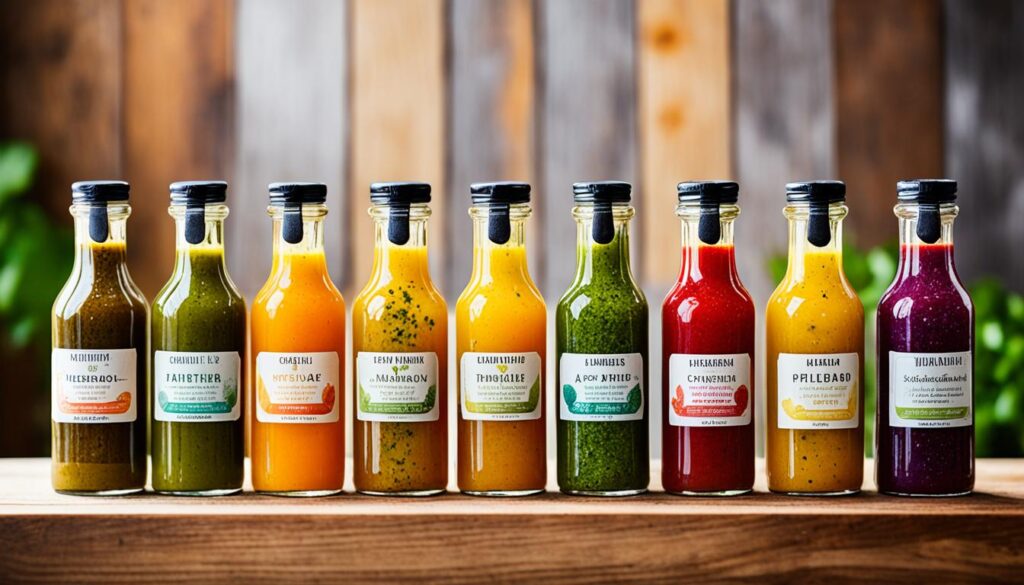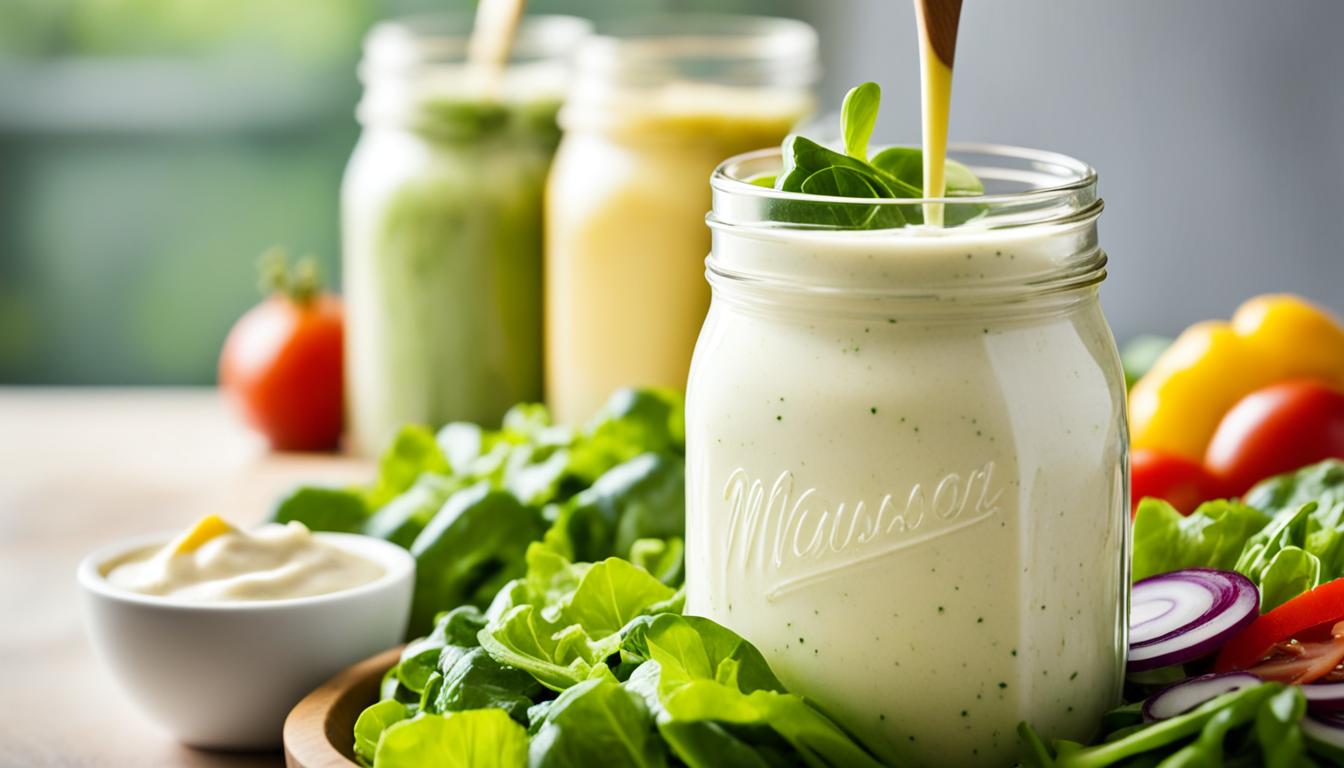Salad dressings and vinaigrettes are a crucial component of a delicious salad. At The Food Lab, we specialize in experimenting with different ingredients and techniques to create the best salad dressings. Whether you prefer store-bought options or are interested in making your own homemade vinaigrettes, we have expert tips and recipes to elevate your greens. In this article, we will delve into the science behind salad dressings, explore various types of dressings, and provide inspiration for your next salad creation.
Key Takeaways:
- Discover the science behind salad dressings and how different components contribute to their flavor and texture.
- Learn expert tips and techniques for making homemade vinaigrettes that allow you to control the flavor and quality.
- Explore popular salad dressings and unique flavors to expand your dressing repertoire.
- Try out delicious salad dressing recipes from The Food Lab to elevate your salad game.
- Find inspiration and insights to enhance your salads and make them unforgettable.
Understanding the Science of Salad Dressing
Understanding the Science of Salad Dressing
To truly appreciate salad dressings, it’s important to understand the science behind them. Salad dressings consist of various components and techniques that contribute to their flavor, texture, and overall appeal. By exploring these basic concepts, you can gain a deeper understanding of how different ingredients come together to create delicious dressings.
Acids: Vinegar and Citrus Juice
Acids play a crucial role in salad dressings, providing tanginess and balance to the flavors. Common acids used in dressings include vinegar and citrus juice. Vinegar, such as balsamic, red wine, or apple cider vinegar, adds a distinctive taste and acidity. Citrus juices, like lemon, lime, or orange juice, provide a refreshing zing and natural brightness.
Emulsions: Combining Oil and Vinegar
One of the fundamental techniques in salad dressings is creating an emulsion. Emulsions are mixtures of two immiscible liquids, such as oil and vinegar, where tiny droplets of one are dispersed within the other. This process helps combine the flavors and textures of oil and vinegar, resulting in a smooth and cohesive dressing.
“Creating a stable emulsion requires the right balance of oil and vinegar, along with the addition of an emulsifier.”
Emulsifiers: Stabilizing the Mixture
Emulsifiers are substances that help stabilize the oil and vinegar mixture in a dressing. They have molecules with both water-soluble and oil-soluble components, allowing them to bridge the gap between the two liquids. Common emulsifiers used in salad dressings include mustard, egg yolks, mayonnaise, and honey. These ingredients aid in creating a smooth and stable emulsion, preventing separation.
Variations and Experimentation
Understanding the science behind salad dressings provides a solid foundation for experimenting with flavors and techniques. You can play with different types of vinegar, vary the oil-to-vinegar ratio, and explore unique emulsifiers to create your signature dressings. Embrace your creativity in the kitchen and let the science guide you on a journey of endless salad dressing possibilities.
| Salad Dressing | Main Ingredients | Flavor Profile |
|---|---|---|
| Balsamic Vinaigrette | Balsamic vinegar, olive oil, Dijon mustard | Sweet, tangy |
| Lemon Herb Dressing | Lemon juice, fresh herbs, garlic, olive oil | Bright, fresh |
| Caesar Dressing | Anchovies, garlic, Parmesan cheese, egg yolks, lemon juice | Creamy, savory |
| Raspberry Vinaigrette | Raspberry vinegar, olive oil, honey, Dijon mustard | Fruity, tangy |
Now that you understand the science behind salad dressings, you can confidently experiment with different vinegar and oil combinations, create emulsified dressings, and explore unique flavor profiles. The possibilities are endless, so embrace your inner food scientist and let your taste buds guide you!
Homemade Vinaigrettes: Tips and Techniques
Making your own vinaigrettes at home allows you to take complete control over the flavor and quality of your dressings. At The Food Lab, we have developed a collection of homemade vinaigrette recipes that are not only simple, but also versatile enough to complement any salad. By following our expert tips and techniques, you can create personalized dressings that elevate the taste and freshness of your greens.
One of the key advantages of making your own vinaigrettes is the ability to customize the ingredients to suit your preferences. Whether you prefer a tangy lemon vinaigrette or a sweeter balsamic blend, you can easily adjust the flavors to create your perfect dressing. Our recipes provide a solid foundation, but feel free to experiment and add your own twist to make it truly unique.
Here are a few tips and techniques to help you master the art of homemade vinaigrettes:
- Use high-quality ingredients: The best vinaigrettes start with the best ingredients. Opt for a good-quality olive oil and vinegar to ensure a superior taste. Experiment with different types of vinegar, such as red wine vinegar, apple cider vinegar, or champagne vinegar, to discover your favorite combination.
- Balance flavors: A well-balanced vinaigrette should have the perfect harmony of acidity, sweetness, and saltiness. Start with a 3:1 ratio of oil to vinegar, and adjust according to your taste preferences. Add a touch of honey or maple syrup for sweetness, and a pinch of salt and pepper to enhance the flavors.
- Emulsify properly: Emulsifying is the process of combining oil and vinegar into a smooth and creamy texture. To achieve this, slowly drizzle the oil into the vinegar while whisking vigorously or using a blender. Alternatively, you can also use a jar with a tight-fitting lid and shake the ingredients until well combined.
- Add flavorful mix-ins: Take your vinaigrette to the next level by incorporating herbs, spices, and other mix-ins. Freshly minced garlic, Dijon mustard, chopped herbs like basil or cilantro, and even grated Parmesan cheese can add depth and complexity to your dressing.
- Let it rest: After preparing your vinaigrette, let it sit for at least 15 minutes to allow the flavors to meld together. This resting time will enhance the taste and ensure each ingredient shines through when dressing your salad.
Now that you have a foundational understanding of homemade vinaigrettes, it’s time to put your knowledge into action. The Food Lab presents a variety of delightful vinaigrette recipes tailored to suit all tastes and preferences. Explore our collection and embark on a culinary journey to elevate your salads to new heights of flavor and freshness.

Balsamic Garlic Vinaigrette
The Balsamic Garlic Vinaigrette is a classic dressing that brings together the rich tanginess of balsamic vinegar with the savory notes of garlic. It’s a perfect addition to greens, roasted vegetables, or even as a marinade for chicken or tofu. Check out the recipe below:
| Ingredients | Instructions |
|---|---|
|
|
Popular Salad Dressings: Exploring Different Flavors
While homemade vinaigrettes offer endless possibilities, it’s also worth exploring popular salad dressings that are widely loved. From classic options like Caesar and ranch to more unique flavors like honey mustard and sesame ginger, there is a dressing to suit every taste. We understand the importance of finding the perfect dressing to enhance your salads, and in this section, we will delve into the traditional and unique flavors of popular salad dressings.
The Classics:
Classic salad dressings like Caesar and ranch have stood the test of time for good reason. Caesar dressing, with its creamy texture and tangy flavor, adds depth to any salad. Ranch dressing, known for its versatility, pairs well with a variety of greens and vegetables. These dressings have become favorites for many salad enthusiasts and are widely available in stores.
Exploring Unique Flavors:
If you’re looking to step outside the traditional options, there are numerous unique salad dressings to experiment with. Honey mustard dressing combines the sweetness of honey with the tang of mustard, adding a delightful twist to your salads. Sesame ginger dressing, with its Asian-inspired flavors, brings a bold and refreshing taste to your greens. These dressings offer a chance to take your salads to a whole new level.
Cooking with Vinaigrettes:
Vinaigrettes, with their blend of oil and vinegar, are not only great for salads but also for cooking. The acidity and flavor of vinaigrettes can enhance grilled meats, roasted vegetables, and even pasta dishes. The versatility of vinaigrettes allows you to use them as marinades, dipping sauces, and more. Get creative in the kitchen and experiment with cooking with vinaigrettes to elevate your meals.
“The combination of different herbs, spices, and ingredients in salad dressings adds depth and flavor to simple greens, transforming them into memorable culinary experiences.”
Expand your salad dressing repertoire and elevate your meals with popular salad dressings and the versatility of vinaigrettes. In the next section, we will share our favorite salad dressing recipes from The Food Lab to inspire your culinary creativity.
The Food Lab Recipes for Salad Dressings
To inspire your culinary creativity, we will share our favorite salad dressing recipes from The Food Lab. These recipes have been meticulously developed and tested to ensure optimal flavor and consistency. Whether you’re craving a creamy Caesar, a tangy balsamic vinaigrette, or a spicy chipotle ranch, our recipes will guide you through the process of creating these dressings from scratch. Step into The Food Lab and unlock the secrets to making delicious and memorable salad dressings.
| Dressing | Description | Ingredients | Instructions |
|---|---|---|---|
| Classic Creamy Caesar Dressing | A rich and tangy dressing with hints of garlic and Parmesan |
|
|
| Tangy Balsamic Vinaigrette | A zesty dressing featuring the sweetness of balsamic vinegar |
|
|
| Spicy Chipotle Ranch | A smoky and spicy twist on the classic ranch dressing |
|
|
Conclusion
At The Food Lab, we invite you to dive into our world of salad dressings and vinaigrettes. Throughout this article, we have explored the science behind dressings, shared expert tips and techniques for homemade vinaigrettes, and taken an in-depth look at popular flavors.
We hope that this journey has provided you with valuable insights and inspiration to elevate your greens. Whether you are a seasoned salad enthusiast or just starting your culinary journey, we are here to guide you every step of the way.
With our collection of carefully crafted recipes and our commitment to the art of dressing salads, The Food Lab is your go-to resource for all things salad dressing. Our aim is simple: to bring out the best in your salads and make your dining experience truly remarkable.
So, next time you prepare a salad, remember to experiment with flavors, embrace your creativity, and use our expert tips and recipes to take your dressing game to the next level. Happy dressing from The Food Lab!
